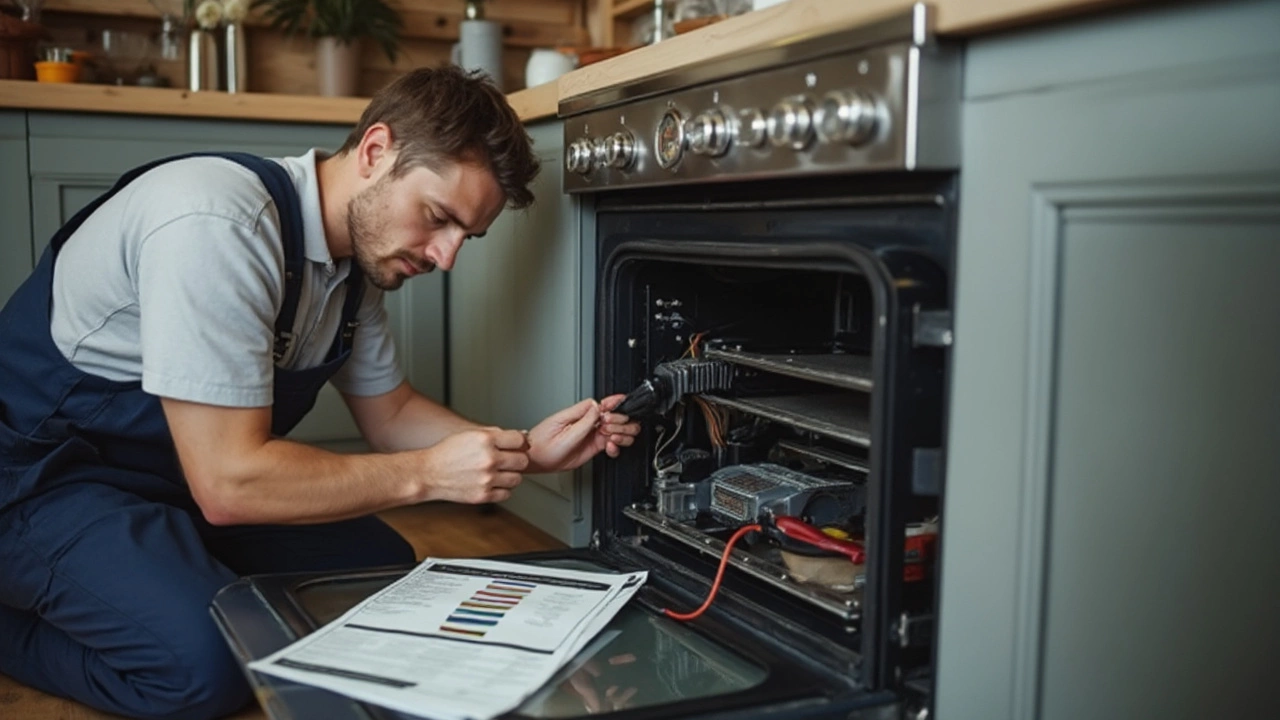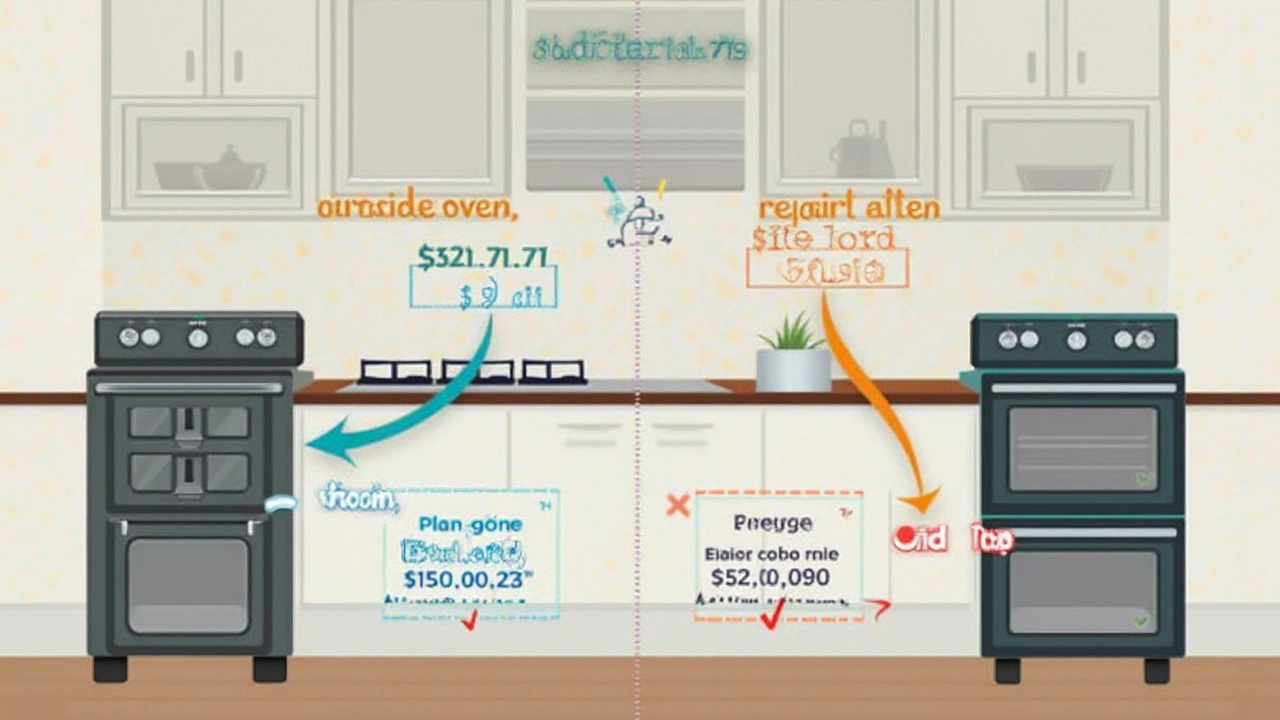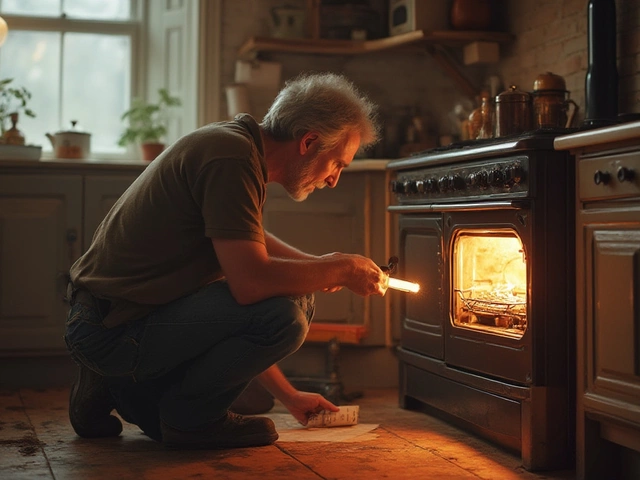A seven-year-old oven sits in that awkward middle age—not exactly new, but not ancient either. So, do you keep sinking money into repairs, or is it smarter to bite the bullet and buy something new?
You’re definitely not alone with this question. Most ovens have a lifespan of about 10 to 15 years, but the decision isn’t just about age. The type of breakdown, your cooking habits, and even the brand can swing the answer either way.
Before you start browsing for a replacement or get out your credit card for repairs, let’s get practical about what really matters—costs, typical issues, and how to tell if your current oven is actually worth fixing. This info can save you from frustration and wasted money down the road.
- How Long Do Ovens Usually Last?
- Common Problems with 7 Year Old Ovens
- Is It Cheaper to Repair or Replace?
- Signs Your Oven Is Worth Fixing
- Tips for Affordable Oven Repair
How Long Do Ovens Usually Last?
So, what’s the real deal with your oven’s lifespan? Most standard electric and gas ovens are built to last between 10 and 15 years if you use and look after them the right way. Everyday wear and tear are totally normal, but not every brand or model pulls off a full decade at peak performance.
Curious about what affects your oven’s mileage? Here’s what really counts:
- Oven repair history and how well it’s been maintained.
- The brand—some entry-level models start giving trouble after 6-7 years, while quality brands hang on longer.
- How much you use it (daily roasts vs. just for holiday baking).
- Whether it’s electric or gas. Gas ovens tend to last a couple years longer on average.
For hard numbers, check this out:
| Oven Type | Average Lifespan |
|---|---|
| Electric Oven | 13 years |
| Gas Oven | 15 years |
If your oven is seven years old, it’s right in the “middle-aged” zone. That means plenty of people get extra years out of models this age, especially if they’ve had just minor repairs, like a replaced element or a new thermostat. But, if it’s been a non-stop headache—maybe one repair after another—it’s worth thinking about how close you are to that average limit.
Common Problems with 7 Year Old Ovens
After about seven years, ovens tend to show their age with a few familiar issues. Some are pretty minor, while others can put a dent in your wallet or even make you question if fixing is worth it at all. Let’s break down what typically goes wrong:
- Heating problems: The most common gripe. Your oven might not heat up, takes forever to preheat, or leaves your pizza undercooked on one side. This usually points to a burnt-out heating element or a failing thermostat. If you notice cold spots, it’s probably an element problem.
- Uneven baking or roasting: Hot and cold spots are a classic sign that something’s off. Faulty fans, temperature sensors, or a misbehaving convection system are often to blame. For folks who love baking, this gets annoying fast.
- Worn-out door seals: When the seal around the door gets tired, heat leaks out. That means longer cooking times, higher energy bills, and sometimes burnt food edges. It’s easy to miss but cheap to fix.
- Malfunctioning controls: Buttons or dials might stop responding or act weird. Digital displays can flicker or go blank. Usually, this comes from years of grease, dirt, or just the circuits aging. Swapping out the control board can be pricey.
- Strange noises or smells: Odd humming, buzzing, or a burnt smell can mean a part is wearing out—maybe a fan motor or an electrical connection. Don’t ignore these. Fires start from ignored smells way more than people realize.
Here's a quick cheat sheet showing the issues, likely causes, and typical repair costs:
| Problem | Usual Cause | Typical Repair Cost (USD) |
|---|---|---|
| Won’t heat up | Heating element, thermostat | $100–$300 |
| Uneven cooking | Fan motor, temperature sensor | $150–$350 |
| Broken door seal | Worn gasket | $25–$75 |
| Control issues | Control board, switches | $200–$400 |
| Strange noise/smell | Motor, wiring | $100–$250 |
The big question: is it worth sinking money into these repairs? You’ll want to factor in the total cost, but knowing which issues are common with a oven repair can definitely help you plan your next move.

Is It Cheaper to Repair or Replace?
Everybody asks this at some point: is it more budget-friendly to fix your seven-year-old oven, or will you save more by just buying a new one? The best place to start is by looking at the actual numbers and typical repair scenarios.
On average, a basic oven repair runs between $100 and $400. That covers things like a broken heating element, faulty thermostat, or a replacement control panel. If you’re dealing with a simple fix, like an oven that won’t heat because of a burned-out element, the repair might be on the lower end of that range. Electronic parts or major components, like a circuit board, push costs higher.
Now, the price of a completely new oven can jump from $400 for a bargain model to over $2,000 for the fancy brands and smart ovens. Installation adds even more, especially if you need electrical tweaks or gas hookups. Don’t forget about hauling away the old oven, which might tack on another $50 or more.
Experts generally agree on the “50% rule”: if your repair bill is more than half the price of a new oven, it probably isn’t worth it—especially if your oven is already halfway to the end of its average lifespan. For a oven repair on a seven-year-old appliance, repairs under $300 usually make sense, but anything approaching $500? Time to rethink.
- Minor fixes like replacing knobs, door seals, or light bulbs usually cost little and can add years to your current oven.
- Major issues (burned-out control boards, serious wiring problems) are expensive and sometimes unpredictable—you could fix one thing, only for something else to fail soon after.
Here’s another angle—energy efficiency. Newer ovens often use less electricity or gas. If your current model drives up your energy bills, the savings from a new, efficient oven can add up over the long haul. But if your old oven works fine outside of the recent hiccup, repairs are still likely your cheapest bet right now.
Signs Your Oven Is Worth Fixing
There are a few clear signs that fixing a seven-year-old oven is honestly a smart move—and not just throwing good money after bad. The trick is to look at what's actually wrong and how much the fix will cost versus a brand new oven.
- Oven repair costs are less than half the price of a new unit. Most technicians say if repair costs are under 40% of the price for a similar replacement model, fixing makes sense.
- The issue is minor, like a broken heating element, bad thermostat, or busted door seal. These parts are cheap and usually quick to swap out.
- Your oven is a well-known reliable brand. Some brands like Whirlpool, GE, and Bosch have a reputation for lasting past a decade with only a couple of repairs needed.
- It hasn’t needed a lot of major repairs before. If this is the first or second small problem, odds are good you’ll squeeze a few more years out of it.
- Replacement parts are easy to find and not outrageously priced. Some high-end or discontinued models can be a headache here, but for most big brands, parts are still on the shelf.
If your situation matches a few of these signs, repairing is the best way to go. Here’s a handy table showing which repairs are cheap and which can turn pricey fast:
| Repair Needed | Typical Cost (USD) | Worth Fixing? |
|---|---|---|
| Heating Element | $75-$200 | Yes |
| Thermostat | $100-$250 | Yes |
| Ignition Switch | $150-$300 | Usually |
| Main Control Board | $250-$550 | Maybe |
| Oven Door Replacement | $150-$400 | Yes |
| Gas Valve | $200-$350 | Maybe |
Another tip: If your oven heats up, cooks evenly, and has never randomly shut off, your core appliance is solid. Small, one-off repairs really do pay off compared to shelling out for a new cooker before you need to.

Tips for Affordable Oven Repair
Nobody wants to spend a fortune fixing a oven repair that might break again in a year or two. Here’s how you can tackle repairs without breaking the bank—and avoid being ripped off along the way.
- Diagnose before you do anything. Sometimes, it’s as simple as a tripped circuit or a blown fuse. Don’t pay for a home visit if the fix is staring you in the face. Most major oven brands provide online troubleshooting charts that help you check common issues like faulty thermostats or heating elements.
- Use genuine or quality aftermarket parts. Cheap, no-name parts from random online shops tend to fail fast. Many reliable sites offer original parts and list compatibility by model. For example, a new heating element averages $40-$100, and can be changed in under 30 minutes with basic tools.
- Compare repair prices. Don’t go for the first quote you get. It’s smart to call at least two or three local repair services. Many now offer fixed-price repairs for common jobs. Always check if the service fee (often $70-$120) includes diagnostics or if it rolls into the total repair bill.
- Ask about warranty on repairs. Legit repair shops will offer a warranty, usually 3-12 months, parts and labor included. If someone won’t put a guarantee in writing, walk away.
- Do simple repairs yourself. Loads of step-by-step guides and YouTube videos cover things like changing oven bulbs, door gaskets, or control knobs. For anything electrical or gas-related, though, call a pro to avoid safety risks.
Here’s what you might expect to pay for standard repairs according to a 2024 service pricing survey:
| Repair Type | Average Cost (USD) | DIY Difficulty |
|---|---|---|
| Heating Element Replacement | $80 - $220 | Medium |
| Thermostat Replacement | $100 - $180 | High |
| Door Seal/Gasket | $30 - $60 | Low |
| Igniter Replacement (Gas Oven) | $120 - $250 | Medium |
| Control Board Repair | $200 - $400 | High |
One last tip: regular cleaning (especially around heating elements and fans) can keep small issues from becoming costly breakdowns. A clogged fan or burnt bits on the element can knock years off your oven’s life. Stay on top of this, and you’ll stretch out the value of your current cooker even further.




